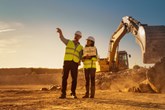Using the power of AI to drive transformation in mining
Published by Will Owen,
Editor
Global Mining Review,
As the mining industry works confront the urgent need to reduce carbon emissions and enhance safety standards for field engineers, operators are now turning to AI for help. In this article, Debashis Ghosh, Global Head of Energy, Resources, and Utilities at Tata Consultancy Services, explores how AI is decarbonising and de-risking mining operations.
Tata Consultancy Services’ (TCS) recent AI for Business Study – which surveyed 90 operators in the Energy & Resources industry, including 48 mining operator and 42 oil and gas companies – found that most Energy and Resource operators (92%) have AI implementations planned, in process, or already completed.
To be sure, miners are already harnessing AI for corporate functions such as safety, procurement, marketing, and regulatory compliance. As they grow more adept with AI, TCS is observing the transformation of fundamental activities like mining and exploration. This shift will redefine the future of mining, making it more efficient, safe, and sustainable.
How is AI reducing emissions?
With more than half of operators (51%) using AI to enhance productivity, TCS has observed that work towards striving for efficiency is driving more sustainable outcomes.
For example, operators are using generative algorithms upstream to analyse ore samples during exploration, accelerating the characterisation of ore bodies and enhancing mining accuracy.
At the operations stage, leading miners are then deploying AI in geology and mine planning to optimise drilling and blasting practices. Here, AI is improving the positioning of drill holes and micro-controlled explosives, making the process safer, but also reducing energy consumption down the value chain in milling and grinding.
It does not stop there; AI is also making the transportation of ore more sustainable. AI is powering the shift towards autonomous haulage of electric mining trucks, significantly spurring the electrification of transportation.
To reduce the carbon emissions of mineral processing, miners are also using AI to improve copper and nickel recovery while reducing reagent usage – providing a market ready mineral with a small ecological footprint.
Trusting AI to mitigate hazards
With this growing digital adoption comes an increased focus on mining operators’ employees. Nearly two-thirds of Energy & Resources executives (63%) say human creativity or strategic thinking will remain their company’s competitive advantage – this is spurring more attention on safety.
The shift towards automation is finally relinquishing workers from hazardous processes such as asset inspections and drilling in remote and harsh environments. The growth of augmented drilling and charging and remotely operated vehicles (ROVs) for inspection prove this as they have already protected thousands of miners from hazardous processes and significantly improved the total recordable injury frequency rate (TRIFR).
AI infused predictions of local seismic activity at mine sites have also reduced incident rates as engineers can be evacuated to safe locations, along with earth moving machinery, at the right time.
With ongoing resource depletion and the urgent need for sustainable operations, the mining industry stands poised to embrace AI-driven innovation for lower emissions and enhanced safety standards for mining operators.
By harnessing the power of AI, miners can not only meet the demands of a rapidly evolving world, but also pave the way for a more sustainable, resilient, and safe future.
Read the article online at: https://www.globalminingreview.com/mining/28062024/using-the-power-of-ai-to-drive-transformation-in-mining/
You might also like
Data goldmines: Advanced analytics optimise brownfields in uncertain times
Jane Marsh, Editor-In-Chief at Environment.co, explores how advanced data analytics and digital technologies can revitalise brownfield mining operations, enabling resource companies to boost yield, reduce costs, enhance safety, and extend mine life.


